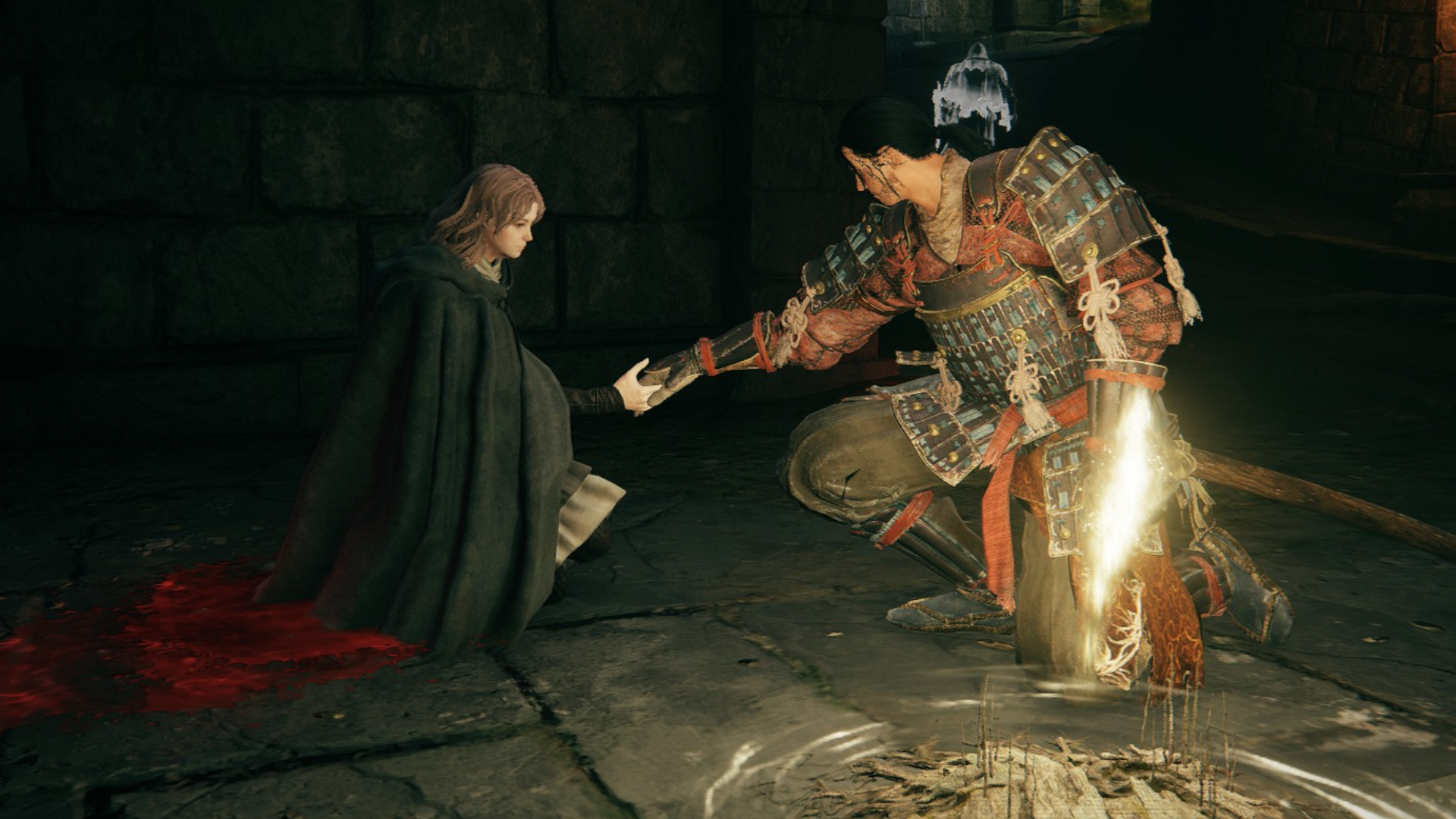
I had a grand old time with Elden Ring: Shadow of the Erdtree—and part of that was because my hours spent trotting around on Torrent were cut back considerably by its quainter scope.

Erdtree map fragments: Uncover the Land of Shadow
Scadutree fragments: How to level up in Erdtree
Erdtree bosses: A full hit list for the DLC
Leda quest: Track the Erdtree main quest
Ansbach quest: Help the former servant of Mohg
Hornsent quest: Complete the quest for vengeance
Shadow of the Erdtree is, as you might have heard, a dense game. It's still open world, and it's definitely bigger than Miyazaki said it'd be, but regardless.
Its legacy dungeons flow into each other, stacked vertically like a multi-layered cake filled with razor blades (also, there is a guy on a boar utterly destroying your birthday party). Its jawbreaker layers are filled with fortresses, caves, goals, and spooky horror movie forests. It doesn't actually take long at all to get from one dungeon to the next, and most of your time is spent spelunking, rather than charging over open fields and half-drowned lakes.
To clarify: I know the DLC does have a handful of zones that are vast and full of nothin'. Namely, the beach to the south, the finger ruins, and a secret underground nightmare I'd rather not spoil.
To me, these places exist more as set dressing—and, save for the utterly gorgeous Shaman Village, I didn't exactly like 'em anyway. Most of Elden Ring's zones trade blows with these empty areas in terms of scope—however, they're pin-pricked with points of interest and mini dungeons, and even if they weren't, Erdtree has less of them.
Give me a moment to dig up my gamer CV—you're welcome to imagine me blowing dust off it as you wait. I've played Dark Souls 1, Dark Souls 2, a little bit of Dark Souls 3, as well as Sekiro: Shadows Die Twice. For most of those games, I've at least done a couple of playthroughs. But when I finally finished all my goals on Elden Ring after 90-odd hours, I put my controller down, closed the game, and basically didn't open it again until Shadow of the Erdtree came out.
Still, Erdtree made me hungry for more Elden Ring. I started anew with a specific build in mind, booted my new save up as John Sekiro the samurai, dunked on the Soldier of Godrick, took a step out into the wide, gorgeous world of Limgrave, and proceeded to go mentally blank for 20 minutes. When I came to, I was staring at an interactive map on a wiki somewhere, wondering just where the hell I should go. Ah, I thought. This is why it took so long.
Memory, all alone in the grace-light

In previous FromSoftware games, the slow, creeping pace of your first playthrough equip you to tear through the whole thing on subsequent runs. I haven't touched the first Dark Souls in ages, but if you put me in front of a controller I'm reasonably confident I could schmoove through the Undead Burg in 30 minutes—an hour, tops.
I don't feel anywhere near as confident running around Elden Ring. I mean, sure, I miraculously killed the Tree Sentinel in three tries, and its legacy dungeons look very familiar. But in terms of where all those vital bell bearings and talismans are, the map's just so big that I'm downright lost without a wiki.
Now Harvey, you might say, it's possible you just have a bad memory. Why yes, I do, imaginary reader—but I've got a decent head on me for directions, as long as I've physically (or digitally) moved around the place before. Even if I sometimes don't know what I had for breakfast, it's notable that I remember more about the landscape of a game I haven't played in 10 years than I do about the world of a game I left for two.
It's notable that I remember more about the landscape of a game I haven't played in 10 years than I do about the world of a game I left for two.
When it came to Shadow of the Erdtree specifically, its thick patches of dungeons made me pay more attention even when it came to its open-world areas. I have a habit of zoning out in most of Elden Ring's fields, but in the great (yet comparatively petite) outdoors of Erdtree, I was always taking stock of my environment—because I knew that I might be able to find a path up or down to my next expedition into the unknown. Aside from the finger ruins, of course, but we've already established I'm not a fan.
In this way, its open world serves it far better, built in part like a legacy dungeon itself, albeit with far wider walls and a skybox instead of a ceiling. Winding halls are replaced with rivers, spires are replaced with mountains, and hidden passages are replaced with repeatedly asking "okay, so how the hell do I get down there."
It's only fair to note that there are absolutely some Elden Ring players with an encyclopedic knowledge of the game. Watch any challenge runner, and they'll be able to enter their mind palace and pull out exactly what they need for their present circumstances like a soulsian Sherlock Holmes. But career Elden Ring players are hardly the norm, even if I respect and fear their power.
There's also another point I'd like to make—Torrent, as much as I love the little guy, makes the process of getting from point A to point B kinda boring if you've already made the trip once before.
The lost art of juking on foot

There's a reason Elden Ring gives you fast travel immediately. Even if you know where to go and how to get what you want out of a new playthrough, the sum of your open world experience will, also, inevitably involve lots of running past monsters in big, empty fields on horseback—particularly when you're already familiar with the place. To make you do so twice would be criminally annoying.
Take the Bridge of Sacrifice in Limgrave, for example. The first time I was there, I hopped off Torrent to fight my way through past its defenses. On my second playthrough, I hit the sprint button and ignored everything just fine with a little jumping, because I had a horse and no one else did.
Granted, juking past enemies was a part of previous FromSoftware games, but at least having to do it on foot made it feel like a puzzle—giving you the same, petty thrill usually reserved for speedrunners when you map out your own personal routes around enemies that can, and will, catch up to you. In Elden Ring, as long as you have access to Torrent, you can outrun basically anything.
Thinking about the way you move overland in Elden Ring, I'm starting to see its conveniences—instant fast travel and a mount that lets you ignore 90% of enemies—as scaffolding that stops FromSoftware's design buckling under the weight of what an open world actually is. This is a company that makes textured, complex, thoughtful games—and it gave itself the task of filling an ocean.
Old man R1s at cloud

Ultimately, though, it might just be my own personal taste—the grumblings of an old fogey who had to earn his stripes by going uphill both ways. After all, my introduction to the series involved a 50% chance you just walked into a graveyard full of unkillable skeletons that'd steal your bones.
Elden Ring's shift into the open world had a lot of advantages—for instance, it allowed FromSoftware to balance difficulty with accessibility, giving you a huge sandbox to roam in whenever you found a boss too hard.
While its challenges stayed brutally tough, players nervous about gitting gud were able to get practice against bite-sized enemies and dungeons that actually gave them rewards, rather than doing it the hard way by dying a lot. It also made for an utterly breathtaking first playthrough. I still remember finding the elevator to the Sifora River Depths and being gobsmacked at just how deep the world went.
Elden Ring's vast open skies and boggling scale meant, for me at least, that it was a one-and-done game back in 2022.
Still. Elden Ring's vast open skies and boggling scale meant, for me at least, that it was a one-and-done game back in 2022. Which is, frustratingly, in direct conflict with some of its other strengths. Elden Ring has over 300 weapons, but I've only ever used a couple—it has a huge variety of builds, but I've only ever experienced it as one of them.
I have the time for difficult games. I will happily sit myself down and spend 10 hours knocking over a boss, as I did last weekend, but by kindly Miquella's golden locks, I sure don't think I've got time to painstakingly comb through a wiki to see if I'm getting all the talismans I want for my build—or getting all the right bell bearings so that I can actually upgrade more than a handful of weapons without going on a scavenger hunt (which'll just involve opening the wiki again).
Why not just explore naturally if you hate wikis so much, then, one might ask? Well, number one, I already did that for around 90 hours. Loved it, but I did it—number two, I just don't really have the raw minutes to do that more than once, even if I wanted to. I'm currently having a decent time on my second playthrough of Elden Ring, but I'm also waiting on Final Fantasy 14: Dawntrail, and as soon as I can see G'raha Tia again I'm gone. Unless I clone myself, which I've considered, believe me.
I want to go face off against Malenia again, I want to fight Margit in his true form for the throne. Heck, I'd even love to just play Shadow of the Erdtree a second time. But it's such a long and winding road to get there that I simply don't have enough time in the day. Shadow of the Erdtree really reminded me that, in my heart of hearts, I wish FromSoftware never went open world.







